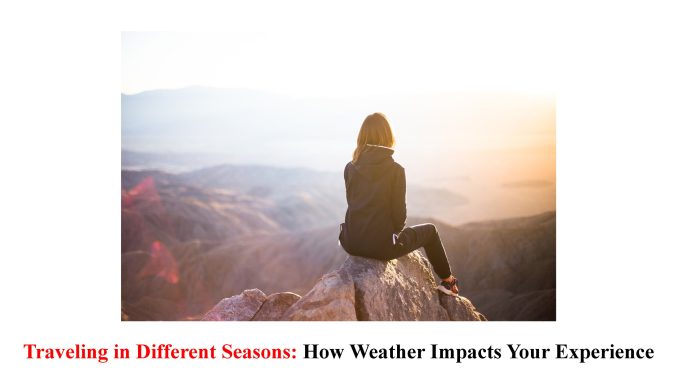
Introduction to the concept of traveling in different seasons
Step into a world where the thrill of travel meets the ever-changing tapestry of weather. Picture yourself exploring vibrant cities, awe-inspiring landscapes, and tranquil beaches in different seasons. Traveling in different seasons offers a unique opportunity to witness destinations through a fresh lens, as each season paints them with its distinct hues. But beware! Weather can be an unpredictable companion on your journey, bringing both delights and challenges along the way. In this blog post, we’ll dive into how weather impacts your travel experience and share tips for making every season shine bright on your adventures.!
The benefits and drawbacks of traveling in each season (summer, fall, winter, spring)
Summer is a popular season for travel, thanks to the warm weather and longer daylight hours. The benefits of traveling in summer are plenty – you can enjoy sunny beach days, go hiking in lush green mountains, or explore vibrant city streets. Summer also offers the opportunity to partake in outdoor activities like water sports, camping, and festivals. However, it’s important to consider that summer is the peak tourist season in many destinations, which means crowded attractions and higher prices.
Fall brings its unique charm for travelers. The changing colors of leaves create a picturesque backdrop for scenic road trips and nature walks. It’s also a great time to visit wine regions during harvest season or indulge in fall-themed festivities like Oktoberfest or Halloween celebrations. However, be prepared for cooler temperatures and potential rainfall during this season.
Winter travel has both pros and cons. On the positive side, winter landscapes covered in snow can be incredibly beautiful and offer opportunities for skiing or snowboarding adventures. Winter holidays such as Christmas markets or New Year’s Eve celebrations add an extra dose of magic to your trip. But keep in mind that winter weather can be unpredictable with cold temperatures and limited daylight hours.
Spring is often seen as a rejuvenating time to travel after the long winter months. Blooming flowers create colorful landscapes while mild temperatures make it ideal for exploring cities or taking leisurely hikes through nature trails. Springtime also brings various cultural festivals around the world where you can experience local traditions firsthand.
Each season offers its own set of advantages and disadvantages when it comes to traveling. By considering these factors while planning your trip, you can maximize your enjoyment regardless of whether you prefer warm beaches or snowy mountaintops!
How to plan for weather-related challenges during your trip
Planning for weather-related challenges during your trip is essential to ensure a smooth and enjoyable travel experience. Here are some tips on how you can be prepared:
1. Research the climate: Before embarking on your journey, take the time to research the typical weather patterns of your destination during the season you will be visiting. This will give you an idea of what to expect and help you pack accordingly.
2. Pack versatile clothing: While it’s important to pack clothes suitable for the expected weather, it’s also wise to include items that can layer easily. This will allow you to adapt to changing conditions throughout your trip.
3. Check local forecasts: Once at your destination, keep an eye on local weather forecasts regularly. Weather can change unexpectedly, so staying informed will help you make any necessary adjustments to your plans.
4. Have a backup plan: In case of inclement weather or unexpected changes in conditions, it’s always helpful to have a backup plan ready. Research indoor activities or alternative attractions that can be enjoyed regardless of the weather.
5. Stay flexible: Despite careful planning, sometimes Mother Nature has other ideas. Embrace flexibility and be open-minded if unforeseen circumstances arise due to adverse weather conditions.
By taking these steps and being prepared for potential challenges related to weather, you’ll maximize your chances of having a fantastic travel experience no matter what nature throws at you!
Tips for making the most out of each season while traveling
When it comes to traveling, each season offers its own unique experiences and opportunities. Whether you’re planning a summer beach getaway or a cozy winter retreat, here are some tips to make the most out of each season while traveling.
In the summer months, take advantage of the longer days and warmer temperatures by exploring outdoor activities. Head to the coast for sun-soaked beach days or embark on a hiking adventure through lush forests and mountains. Don’t forget your sunscreen and pack plenty of lightweight clothing to stay cool in the heat.
As fall rolls around, embrace the vibrant colors of changing leaves and indulge in seasonal treats like apple cider and pumpkin pie. Visit picturesque towns renowned for their autumn foliage or go on a scenic road trip through the countryside dotted with pumpkin patches and corn mazes. Be sure to pack layers as temperatures can vary throughout the day.
Winter brings its kind of magic, with snow-covered landscapes perfect for skiing, snowboarding, or simply enjoying hot cocoa by a roaring fireplace. Consider visiting destinations known for their winter wonderlands such as ski resorts in Europe or charming Christmas markets in Germany. Bundle up with warm coats, hats, gloves, and boots for maximum comfort.
Spring is a time for renewal and blooming flowers. Experience this rejuvenation firsthand by visiting botanical gardens or attending cherry blossom festivals in Japan or Washington D.
C., depending on where you want to travel! Pack rain gear as spring showers can be frequent but also remember lighter clothing options for when temperatures start rising.
Remember that weather conditions can change rapidly during any season so it’s important to stay flexible with your plans and be prepared for unexpected changes. Check local weather forecasts before heading out each day so you know what to expect temperature-wise along with any potential storms that could affect your travels.
By considering these tips when planning your travels throughout different seasons, you’ll be able to fully embrace all that each has to offer – from sunny adventures by the water’s edge to cozy retreats in snowy mountain towns. Happy travels!
Destination-specific examples of how weather can enhance or hinder your experience
1. Tropical Paradise: Imagine lounging on a pristine beach, sipping a refreshing cocktail under the warm sun. In destinations like Bali or the Maldives, the summer months offer ideal conditions for soaking up the sun and enjoying water activities such as snorkeling and surfing. However, during the monsoon season, heavy rains may disrupt outdoor plans and limit visibility in underwater attractions.
2. Fall Foliage: If you’re planning to visit New England in the United States or Japan during autumn, you’ll witness nature’s breathtaking transformation. The vibrant hues of red, orange, and yellow create picture-perfect landscapes that are perfect for hiking or scenic road trips. On the downside, unpredictable weather patterns may lead to sudden rain showers or chilly temperatures requiring layered clothing.
3. Winter Wonderlands: Picture yourself skiing down powdery slopes amidst stunning mountain scenery in destinations like Switzerland or Canada’s Rocky Mountains during winter. Snow-covered landscapes evoke a magical atmosphere perfect for winter sports enthusiasts. Be prepared for sub-zero temperatures though and ensure you have appropriate cold-weather gear to stay comfortable outdoors.
4. Spring Blooms: Cherry blossoms in Japan or tulip fields in the Netherlands are just some examples of how spring brings new life to various destinations around the world. Exploring botanical gardens adorned with colorful flowers is an enchanting experience that shouldn’t be missed! Keep in mind that spring can bring occasional rain showers as well as fluctuating temperatures necessitating layering options when packing.
Remember that each destination has its unique climate patterns throughout different seasons; always research beforehand to make informed decisions about when best to visit based on personal preferences and desired experiences
Conclusion: The importance of considering weather when planning your travels and embracing the unique experiences each season has to offer
The Importance of Considering Weather When Planning Your Travels
As we have explored in this article, considering the weather when planning your travels is crucial to ensuring a memorable and enjoyable experience. Each season brings its benefits and drawbacks, and understanding how weather can impact your trip allows you to make informed decisions.
Traveling during the summer offers long days filled with sunshine, perfect for beach getaways or outdoor adventures. However, it also means dealing with larger crowds and higher prices in popular tourist destinations. Fall brings stunning colors as leaves change, creating a picturesque backdrop for exploring nature. Yet, unpredictable weather patterns can sometimes disrupt plans.
Winter travel opens up opportunities for winter sports enthusiasts and those seeking cozy retreats by the fireplace. On the flip side, frigid temperatures and snowstorms can present challenges that need careful preparation. Spring welcomes blooming flowers and milder temperatures but may also bring occasional rain showers that require flexibility in itinerary.
By planning and packing accordingly, you can overcome many weather-related challenges during your trip. Researching destination-specific climate conditions will help you pack appropriate clothing layers or necessary gear such as umbrellas or waterproof jackets. Additionally, staying updated on local forecasts while traveling helps avoid surprises.
To make the most out of each season while traveling:
1) Embrace the unique experiences: Instead of focusing solely on potential drawbacks, embrace what makes each season special at your chosen destination.
2) Be flexible: Prepare alternative indoor activities or backup plans in case of inclement weather.
3) Pack essentials: Bring versatile clothing options that allow you to adapt to changing conditions.
4) Seek local advice: Locals often have valuable insights into navigating their region’s specific climate challenges.
5) Capture memories: Use different seasons as an opportunity to capture diverse landscapes through photography.



Leave a Reply